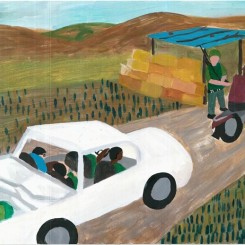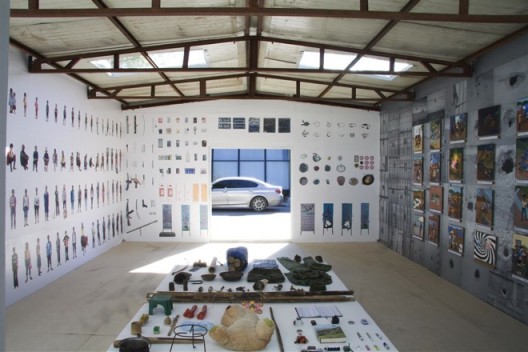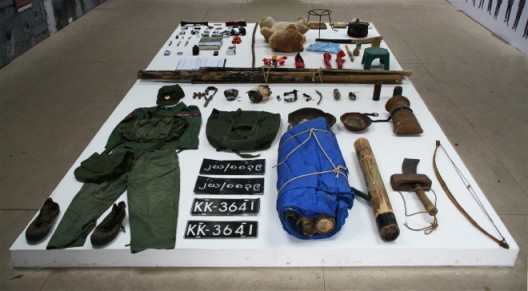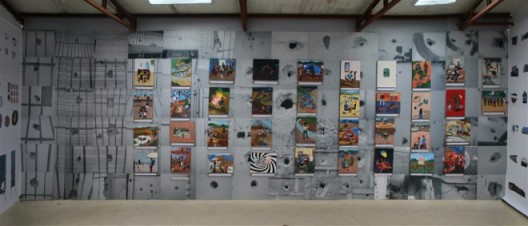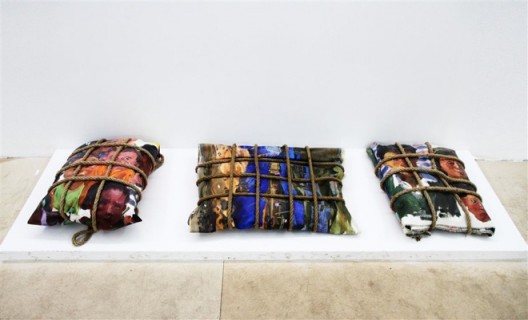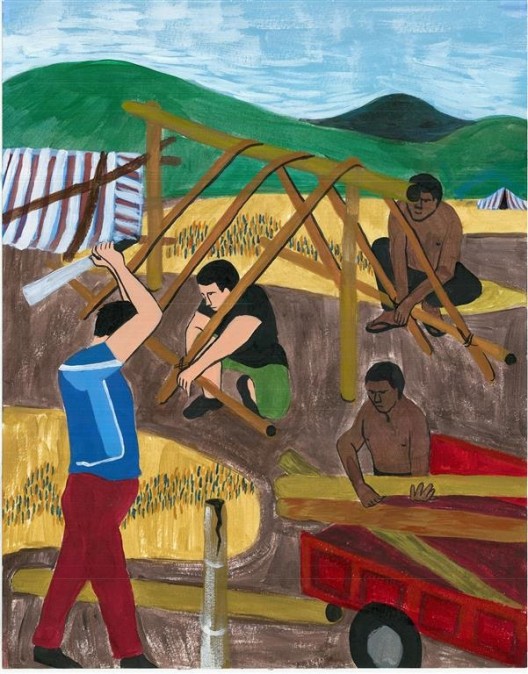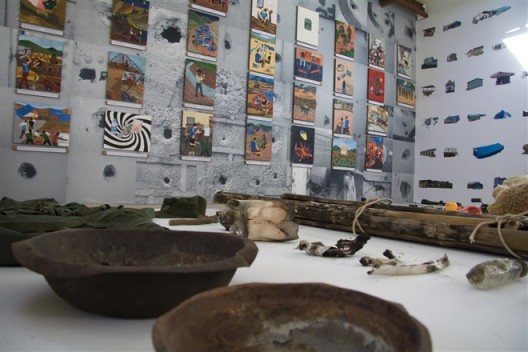This review is included in Ran Dian’s print magazine, issue 3 (Spring 2016)
“About the War in Northern Myanmar”
Gallery Yang, (No.20, East of 798 Originality Square, B District in 798 Art Zone, Beijing, China), October 28–November 25, 2015
A temporary building appeared on “Originality Square” in the 798 Art District in front of—and almost concealing—Gallery Yang. The building was the type used for functional purposes next to construction sites to stash away equipment, or for temporary events as entrances to otherwise too-small premises as a place to keep personal effects during show time. At first glance it was quite inconspicuous, but when you took a closer look, the graphic black and white, paper-cut-style on the outside of the structure revealed some upsetting imagery. What appeared to be a scenic view of a wide landscape complete with flowers, trees, a couple of tents and clouds sailing in the background turned into a virtual warzone with soldiers lurking in the undergrowth; a child and a pregnant woman wandered along aimlessly, though a beheading seemed imminent. This sort of presentation is very uncommon in Beijing’s highly controlled art environment, where images of violence, sex, etc. always raise flags.
Upon entering the building, the experience became one of a museum of contemporary conflict juxtaposing real-life artifacts with what appeared to be folk art and documentary photography. A flat pedestal in the center of the first room gave space to different kinds of protective gear, cooking utensils and hunting devices that were obviously brought to Beijing from afar. The wall directly ahead displayed shacks and other makeshift architecture, creating a weird moiré of sorts with the exhibition’s own premises. There were also cropped-out photographs of individuals, beginning with children, on the top-right corner of the right-hand wall; they grew older as your view panned to the right, becoming teenagers, finding work, becoming parents themselves, then soldiers wielding weapons. A strange sense of classification took place on this wall, as if someone had picked a distinct specimen of a population being researched and had them pinned up like butterflies at distinctive moments of their phylogeny. The left-hand wall was visually the densest in this room, and verged on being indecipherable. A gray backdrop was comprised of slightly differently sized photocopies of images of bullet-holes in concrete, glued onto the wall in an off-grid; on top of these, thirty-eight semi-naïve paintings on cardboard were displayed in a similarly fluttering fashion. Once you got beyond the barely legible wall text on top of the bullet hole-images on the left of the wall, you were assailed by the visual overkill of small, brightly colored paintings on the same wall. Each of these cartons revealed an episode of what appeared to be a visual diary of sorts, of life in a camp. Short texts accompanying the images illuminated the situation in what is apparently a refugee camp in the northeastern part of Myanmar, located in the so-called the “Golden Triangle” of the Kokang territory.
When Aung San Suu Kyi’s party, the National League for Democracy, won the elections in Myanmar on November 8, 2015, it was widely celebrated as a victory for democracy against a military junta that has ruled the country for decades. As a country made up of a Burman core along with disparate ethnic groups on its borderlands, Myanmar since independence from the rule of the British Raj has faced long-running rebellions and civil conflict on its margins; this has not been helped by Thai meddling in the Shan states or by the fact that “remnant armies” of the Kuomintang fled to the border areas between China and Myanmar after their defeat in the Chinese Civil War after 1949. In this vacuum, warlords arose, funding their fiefdoms by growing opium. Indeed, in 1989, the drug lord Pheung Kya-shin (Peng Jiasheng) declared the Kokang territory (mostly inhabited by Han Chinese) between China, Thailand, and Myanmar an autonomous region. This “Golden Triangle” has become one of the biggest producers of illegal narcotics worldwide, just second to Afghanistan.
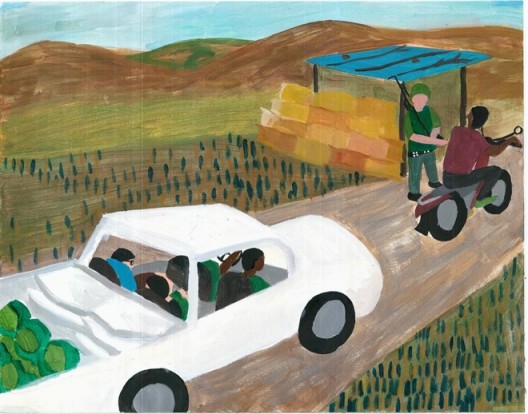
张玥和包晓伟,《睡到半夜,一名同盟军的小士兵跑进帐篷把我们推醒,说他们的连长被炮弹炸断了腿,让我们出一百五十元钱,包晓伟掏出钱给了他们,我惊叹难民营里消息传递之快。心想接下来的生活会充满很多不安全的因素》,卡通插画,2015(图片由艺术家和杨画廊提供) / Zhang Yue and Bao Xiaowei, “At midnight, still sleeping, we were awaken by a young soldier of the Alliance Army. He said their captain had had his leg broken by a cannon shot, and demanded us to contribute 150 yuan. Bao Xiaowei gave him the money. I wondered how fast information was transmitted in the camp, and thought that our ensuing lives would be full of unsafe elements”, cartoon, 2015 (courtesy of the artist and Gallery Yang)
Into this region two artists, Zhang Yue and Bao Xiaowei, decided to travel after a wild night of debate and drinks with their curator friend Cui Cancan, during which they were riffing on Soviet-style literature and its embedded educational content, where a life well spent has to be a life in the service of the people—“striving for the liberation of mankind,” as one of their primary school textbooks had said. Interestingly described by Cui, texts like those leave most of the younger generation of Chinese artists with a sense of obsolescence; yet, in its negative form, this ties them back to a romantic/revolutionary notion of the world they can neither subscribe to anymore, nor completely dismiss. The result is a deeply ambivalent exhibition, plainly titled “About the War in Northern Myanmar.”
What at the outset appeared to be a collection of documentary objects in a shack turned out to be a finely balanced and intricately nuanced artistic and/or curatorial project that pushed the boundaries of what passes as art in the context of Chinese discourse and the constraints of what can be shown publicly. As a result, the visual rhetoric employed in the show was multi-fold. Quite obviously, the cartoonish paintings weren’t folk art at all, but a way to blunt the edge of documentary photography just a little bit so as to make it past the censor. They were in fact intimately recorded vignettes of life in the refugee camp—stories of orphaned kids adopting (or at least trying to adopt) a new parent, husbands prostituting their wives for mere subsistence, promiscuity in the face of daily terror, and so on and so forth—quite shocking in their scope and complexity. In tune with the “real” objects brought from the camps and the cropped-out images of individual people—like a visual translation of their lives’ uprootedness—and the crescendo of the bullet holes, the first room engulfed the viewer synoptically in one view of the war. At once factual and highly emotional, the exhibition placed its story front and center. Any kind of artistic ambition seemed to vanish behind the objects on display. Does it matter if the hatchet had the status of an artwork, or if, whatever (bloody story, say) that object brought across, it went directly to the viewer’s mind?! Does it matter if the colorful cartoons were so skillfully painted that they actually passed for folk art?! Yet even if artistic ambition seemed to have taken the back seat, everything was presented in such a nervously accurate and precisely scattered way that there could hardly have been a better way of presenting the subject matter. You felt the anxieties related to the show seeping through whatever formal, artistic, or curatorial decision had been made. And it does not really matter if the anxiety is derived from the show’s content—war in Myanmar—or actually from uncertainty about what will happen with a highly charged exhibition like this in the heart of Beijing’s art world. There was risk involved in going into a war zone and there was (a different) risk involved in actually presenting this show. Taking the back seat artistically also might have served a tiny bit as an insurance policy against the latter risk. The result, however, was conceptually and contextually very convincing for exactly those choices.
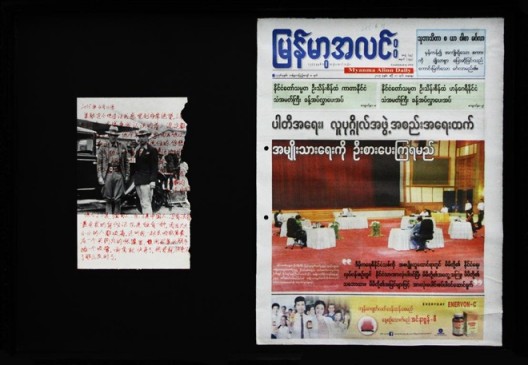
张玥,《日记》,展览的一部分,2015(图片由艺术家和杨画廊提供)/
Zhang Yue, “Diary”, part of the installation, 2015 (courtesy of the artist and Gallery Yang)
But wait: there was a second space within the temporary museum to the war in Myanmar. Most notably, some kind of big Excel spreadsheet dominated the room, recording the distribution of rice to people living in the refugee camps. It turned out that the artists had gone to Kokang twice, and that upon returning to Beijing after the first time, had managed to sell enough artworks to buy some twenty tons of rice which on their next journey they then distributed among the 6364 individuals in the camp, sustaining them for just one month. Forget highly artificial discussions about Relational Aesthetics in the West. This was real and part of a presentation cares not for arcane discourses. Is there symbolic benefit to the artists for distributing rice? Maybe, but they were not milking the situation. There was not a single image of them giving out rice to a cute, starving child or a wretched old person. Again, it was a more matter-of-fact approach that radiated the scruffiness necessary to actually function in a dangerous environment like that, without the support of an entire entourage or security personnel. There was video footage of life in the camp, a video diary that Zhang Yue kept in which he reflects on his experiences and tries to come to terms with it. There were scraps of paper with notes about life in the camp, along with some invoices—proof that the journey was real and not just made up. The second room showed a totally different engagement with the topic of the exhibition, but also one that is completely in tune with “striving for the liberation of mankind.”
The show did not point fingers. It did not look at the macro level of whatever fucked-up major interests have shaped the Kokang territory. It looked at the lives of the people in a very concrete way. It was, of course, the big (and old) question about art and life that was being asked. How do the existential and the symbolic worlds converge? Which side benefits more from this encounter? Is art really about the noble cause of “striving for the liberation of mankind”? Or, to put it differently: can art change society? If one is inclined to look at the sum total of this exhibition, what matters more? Providing food for a month for a community, or taking a risk to expand the scope of what kind of art can be shown in Beijing? The answer is: it doesn’t matter. Both things exist almost independently. It is not necessary to feed people to make good art, and it does not have to be art to feed people. It is not what you do, but how you do it that makes it either a good deed or good art. In the case of “About the War in Northern Myanmar”, Zhang Yue and Bao Xiaowei succeeded in both, making this the most memorable show in Beijing in 2015.
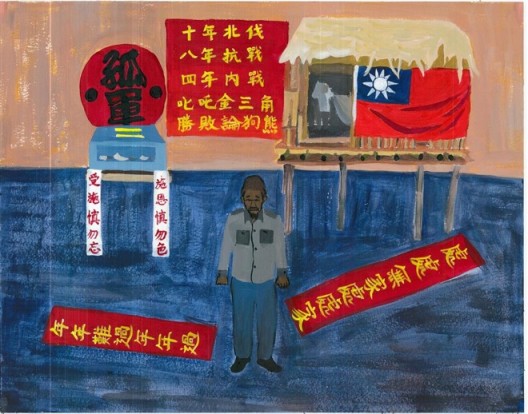
张玥和包晓伟,《夜里无论几点都会听到摩托车的声音,后来看见才知道有人从中国地越境来难民营买毒品》,卡通插画,2015 (图片由艺术家和杨画廊提供)/ Zhang Yue and Bao Xiaowei, “However late at night, we could hear the sound of motorcycle. We learned from our own eyes that it was someone coming from China to buy drugs”, cartoon, 2015 (courtesy of the artist and Gallery Yang)

